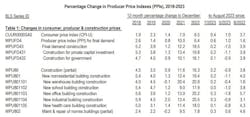AGC: Diesel prices increase construction input costs
The price of materials and services used in nonresidential construction increased 1.1% from July to August, driven by an extreme jump in diesel fuel costs, according to a recent analysis by the Associated General Contractors of America.
Association officials noted that most other commodity prices were subdued but said their newly released survey showed contractors continue to experience widespread problems finding qualified workers and the costs associated with those shortages.
“The steep climb in diesel prices since July is a reminder that construction cost worries have not gone away,” Ken Simonson, the association’s chief economist, said in a news release. “An even great challenge for most contractors is finding enough qualified workers to complete the many projects available to work on.”
The producer price index for diesel fuel, which covers the selling price at the terminal rack or refinery, soared 34.6% from mid-July to mid-August, the largest one-month jump since 1990. Simonson noted that retail diesel prices have continued rising since then and have climbed 77 cents per gallon in the past 10 weeks.
The 1.1% monthly increase in construction input costs was the largest since January, Simonson pointed out. In contrast, the index for new nonresidential building construction—a measure of the bid prices contractors said they would charge to erect a set of new structures—edged up just 0.2% in August. He noted that both indexes posted relatively mild year-over-year changes: 0.1% for inputs and 4.0% for bids.
Prices for most major construction inputs other than fuel were stable or declined in August. Indexes for cement and architectural coatings such as paint were flat. There were decreases of 0.2% in the index for plastic construction products, 0.5% steel mill products, and 0.4% for gypsum building materials.
The association’s annual workforce survey, conducted with Autodesk, found that 85% of respondents reported having job openings for hourly craft workers or salaried workers. Of firms with openings, 88% reported difficulty filling craft positions and 86% reported the same for salaried openings; and 61% of firms experiencing projects delays attributed them to a worker shortage.
Association officials added that the survey results highlight the need for significant education and training reforms to expose more future workers to construction career opportunities and to provide them with basic employment skills needed to be successful. They noted that two-thirds of contractors reported many candidates lack the skills needed to be employable.
“The nation’s current approach to preparing future workers is not working for high-paying sectors like the construction industry,” said Stephen E. Sandherr, the association’s CEO. “As a result, contractors in many parts of the country are struggling to find enough people to keep pace with demand.”

